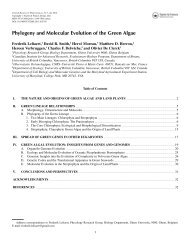Phylogeny and molecular evolution of green algae - Phycology ...
Phylogeny and molecular evolution of green algae - Phycology ...
Phylogeny and molecular evolution of green algae - Phycology ...
You also want an ePaper? Increase the reach of your titles
YUMPU automatically turns print PDFs into web optimized ePapers that Google loves.
10 CHAPTER 1<br />
Green algal phylogenies<br />
The estimated divergence time between Streptophyta <strong>and</strong> Chlorophyta varies considerably among<br />
studies. The split between these lineages is generally situated in the Neoproterozoic to late<br />
Mesoproterozoic (Fig. 7) (between 1200 <strong>and</strong> 700 million years ago: Douzery et al. 2004, Hedges et al.<br />
2004, Yoon et al. 2004, Berney <strong>and</strong> Pawlowski 2006, Roger <strong>and</strong> Hug 2006, Zimmer et al. 2007, Herron<br />
et al. 2009). The ancient age in combination with the short time span over which the major lineages<br />
<strong>of</strong> <strong>green</strong> <strong>algae</strong> diverged likely caused the unstable relationships among these classes. Determining<br />
relationships among the different orders <strong>of</strong> the Ulvophyceae poses a similar problem. Up to now,<br />
<strong>green</strong> algal phylogenies using a broad taxon sampling were always based on SSU nrDNA (Zechman et<br />
al. 1990), while studies using whole plastid genome sequences contend with a small taxon sampling<br />
(Pombert et al. 2004, Pombert et al. 2005). It is well-known that phylogenetic information contained<br />
in a single gene is <strong>of</strong>ten insufficient to obtain firm statistical support for deep nodes (Philippe et al.<br />
2005). Hence, improved character sampling by the inclusion <strong>of</strong> a larger number genes <strong>of</strong>ten leads to<br />
more accurate estimates <strong>of</strong> phylogenetic relationships. Unfortunately there is a limited availability <strong>of</strong><br />
genomic data for <strong>green</strong> <strong>algae</strong>. Whole genome sequences were only available for the chlorophycean<br />
Chlamydomonas reinhardtii <strong>and</strong> the prasinophycean Ostreococcus tauri at the start <strong>of</strong> this project.<br />
Some other whole genome sequences have been recently released or are on the way for the<br />
chlorophyceae Volvox <strong>and</strong> the prasinophytes Micromonas <strong>and</strong> Bathycoccus. However, up till present<br />
no genome has been sequenced for a representative <strong>of</strong> the Ulvophyceae or Trebouxiophyceae. In<br />
addition to whole genome sequences, there are small to moderately sized EST libraries <strong>and</strong> complete<br />
organelle genomes available for some <strong>green</strong> <strong>algae</strong> (table 2). However, the ulvophycean seaweed<br />
orders remain underrepresented: no sequenced plastid genome <strong>and</strong> only 2 smaller EST libraries are<br />
available.<br />
This limited availability <strong>of</strong> genomic information for the Chlorophyta inevitably poses a restriction on<br />
taxon sampling. Most studies which have addressed deep relationships <strong>of</strong> Chlorophyta are seriously<br />
constrained in taxon sampling (e.g., Pombert et al. 2005, Rodriguez-Ezpeleta et al. 2007).<br />
Furthermore, sparse <strong>and</strong> uneven taxon sampling, with most species belonging to either the<br />
prasinophytes or Chlorophyceae, increases the risk <strong>of</strong> systematic error due to long branch attraction<br />
<strong>and</strong> other biases (Verbruggen <strong>and</strong> Theriot 2008).<br />
Resolving deep <strong>green</strong> algal relationships will inevitably request the combined analysis <strong>of</strong> many<br />
markers. Since genomic data are rare, it will be necessary to design primers for new markers. Lowcopy<br />
nuclear markers proved to be good c<strong>and</strong>idates due to a higher <strong>evolution</strong>ary rate than organellar<br />
genes, the potential to analyze multiple unlinked genes <strong>and</strong> the bi-parentally inheritance (Small et al.<br />
2004). However, the greater difficulty <strong>of</strong> isolating <strong>and</strong> characterizing low-copy nuclear markers in<br />
comparison with SSU nrDNA <strong>and</strong> chloroplast genes which can be amplified with universal primers<br />
<strong>and</strong> the difficulty <strong>of</strong> assessing orthology are the major challenge when using low-copy nuclear<br />
markers (Small et al. 2004).

















